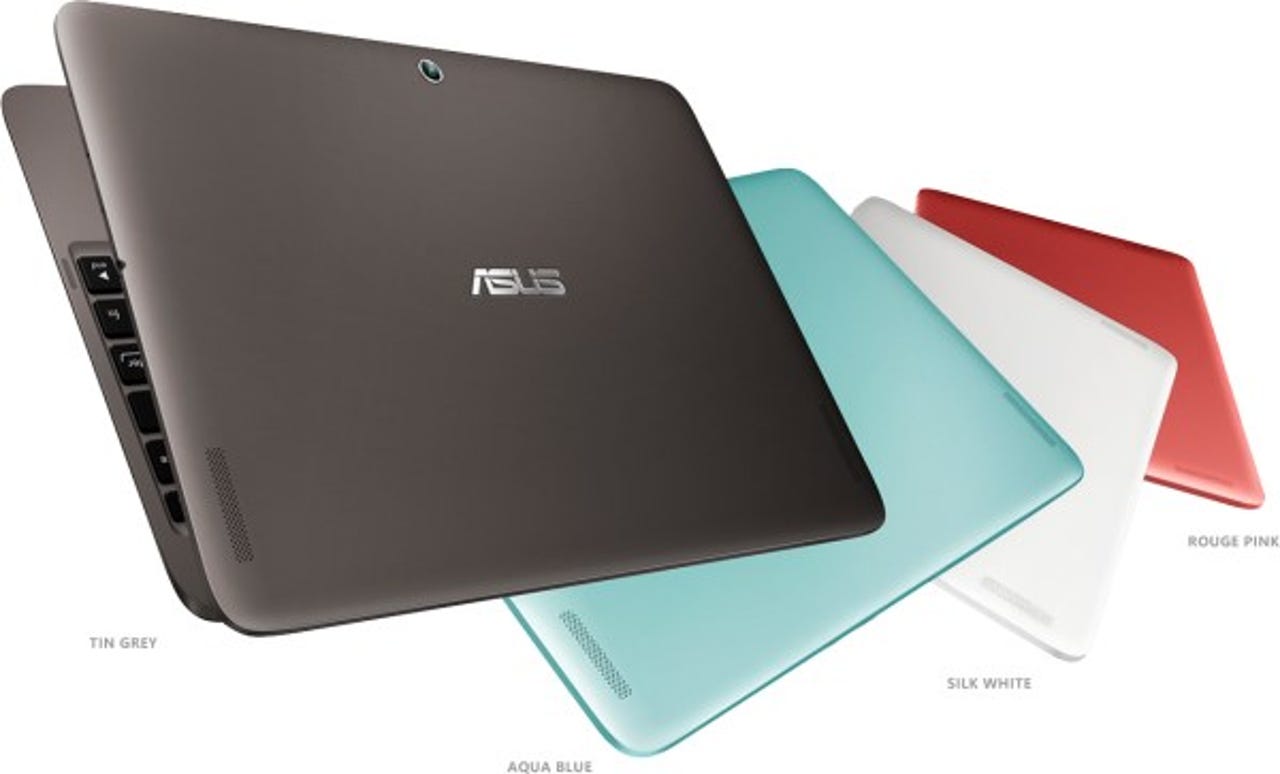Hands on the Asus T100HA, which upgrades a popular Windows 2-in-1


The format is familiar. The T100HA comprises a 10.1-inch tablet and a keyboard dock. The connection is made by two pins/slots and magnets, and it's secure enough: you can pick it up by either the keyboard or the screen. If you hold it upside down, you have to shake quite hard before it comes apart.
But yes, it does have the usual drawback: the tablet is heavier than the keyboard dock, so the hinge stops you from pushing the screen back to the point where it tips over. However, the combination is fine for typing things with the T100HA in your lap. (I'm doing it now.)
The tablet part of the T100HA measures 265 x 175 x 8.45mm (10.43 x 6.89 x 0.33 inches) and weighs 0.58 kg (1.28 lbs). The two parts combine to form a very portable laptop that's 16.5mm thin and weighs about 1kg.
The touch-screen tablet has an on/off button, a volume rocker, front- and rear-facing webcams, tiny stereo speakers, plus Wi-Fi and Bluetooth. It also has a reasonable selection of ports: the aforementioned USB Type-C (USB 3.1 compatible), a microUSB port used for charging, microHDMI, a microSD card slot, and an audio jack for headphones. The keyboard provides an extra USB port and a touchpad, but no secondary battery.
The screen is bright and sharp, though the resolution is limited to 1280 x 800 pixels. (The original T100 did the usual 1366 x 768, but this doesn't make any real difference.) Although the screen isn't matt, it's not glossy enough to be annoying.
The keyboard is a bit of a mixed bag. If you have a 10.1-inch screen, the keys are inevitably going to be small. However, they don't have to be squashy. At first, I thought the keyboard was better than the one with the original T100TA, but not having the two to compare, I'm not so sure.
You can certainly get used to the T100HA keyboard, and it seems to work OK (apart from the occasional doubled letters). But it could and should be better, and the one on my similar 10.1-inch Lenovo Miix 3 (which I reviewed here a month ago) is noticeably better.
Performance
The T100HA performs well, considering its size and price. The review sample had a 14nm 1.44GHz quadcore Intel Atom x5 Z8500, which is an improvement on the previous 22nm Z3740: it's faster and has better graphics. Indeed, it's slightly faster than a Core i3-3229Y and fractionally slower than a Core i3-4005U.
On the deprecated Windows Experience Index, the CPU scored 6.6 (up from 6.3), the graphics 4.9 (up from 4.1), and the Flash drive 7.0 (up from 6.2), with RAM getting the expected 5.5. The T100HA actually scored 9.9 for gaming graphics, which is an anomaly - the maximum should be 7.9! Still, while this is not, in any sense, a games machine, it can run older games better than you would expect.
For comparison, run the free NovaBench benchmark on your current PC and see 9ow the T100HA stands up. On NovaBench, the T100HA's CPU scores 258, the RAM gets 105, the graphics 36, and the 64GB eMMC Flash memory drive scores 9, with a total score of 408. The numbers for my Lenovo Miix 3 are 202, 107, 22 and 5 respectively, with a total score of 336.
In general terms, the T100HA is a cut above today's average 2-in-1, but not up to the level of the Atom-powered Microsoft Surface 3.
It certainly delivers enough performance for everyday computing, including web surfing, Microsoft Office, playing videos and so on. It has no problems multitasking desktop programs, though that's ultimately limited if you have the standard model with only 2GB of memory.
As with the original T100, battery life can be extremely good, especially if you turn on the battery saving features. In normal use, with Wi-Fi turned on and screen brightness on high, I was getting a bit over 7 hours of battery life. With Wi-Fi and Bluetooth off and more moderate settings, the claimed "12 hours of video playback" should be within range. But if you run out of power, you can probably recharge it with your smartphone's microUSB charger, so there's no need to pack an extra "brick".
Conclusions
Back in the days when Windows XP and other dinosaurs walked the earth, some of us got excited about netbooks: they were slower than traditional laptops and had letterboxy 1024 x 600-pixel screens, but they were much smaller, much cheaper, and had better battery life. Asus sold zillions.
The T100HA is much like a netbook but it's faster than those traditional laptops used to be. It also has a touch screen - so it doubles as a tablet - and a vastly better operating system for around the same price.
Of course, that was also true of the Asus T100TA. If you have one of those, this is not enough of an upgrade to be worth the cost. If not, it's a contender for lightweight business travel and home use in front of the TV, or whatever.